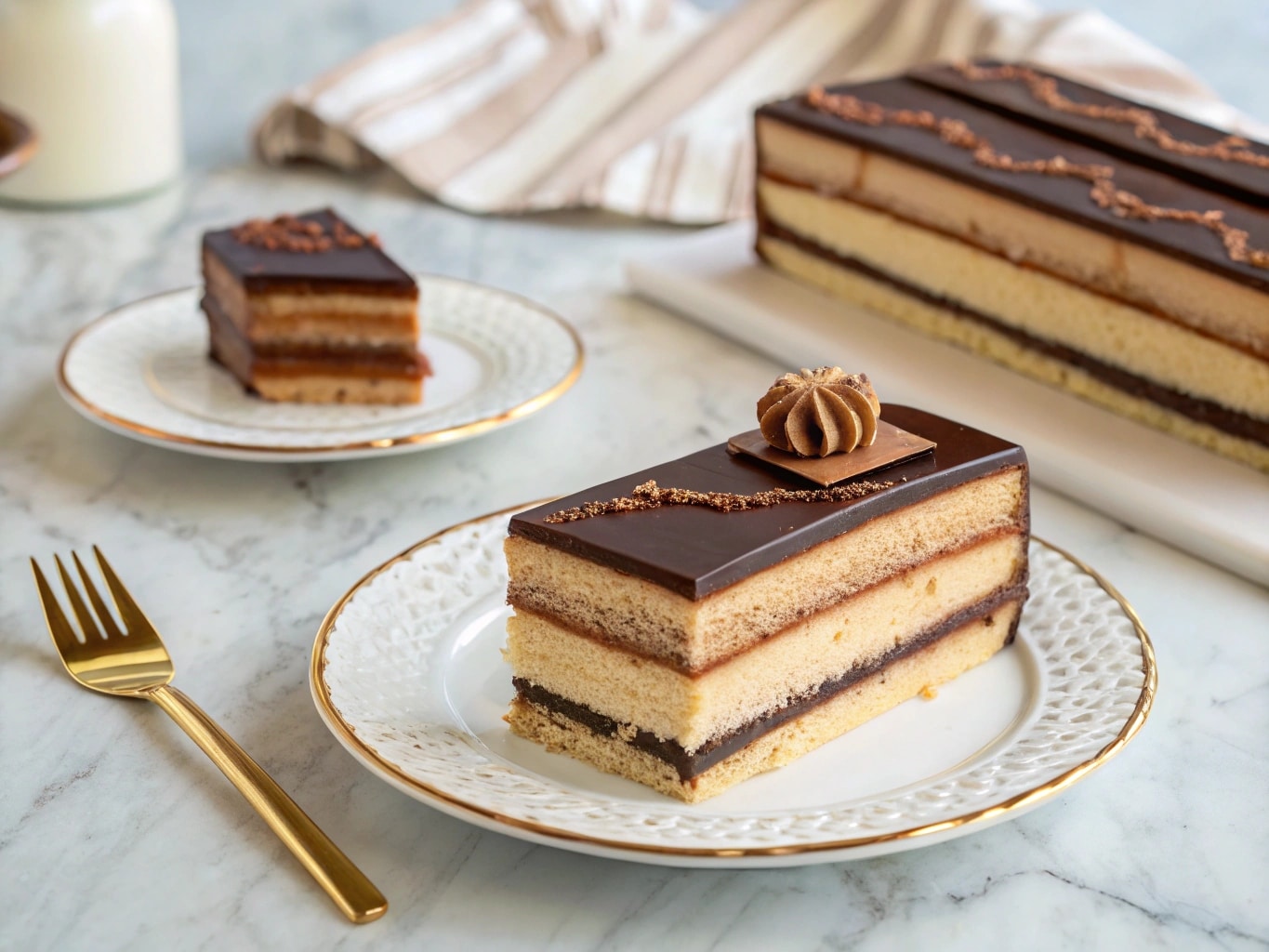Opera cake isn’t just dessert—it’s a story layered with tradition, flavor, and elegance. In this article, we’ll share the history and artistry behind the French masterpiece, compare variations, and give you a step-by-step recipe to create this indulgent treat at home. Along the way, you’ll learn how to balance textures, why each component matters, and how to make your version taste like it came straight from a Parisian pâtisserie. Whether you’re curious about the origins or eager to bake, this guide covers it all.
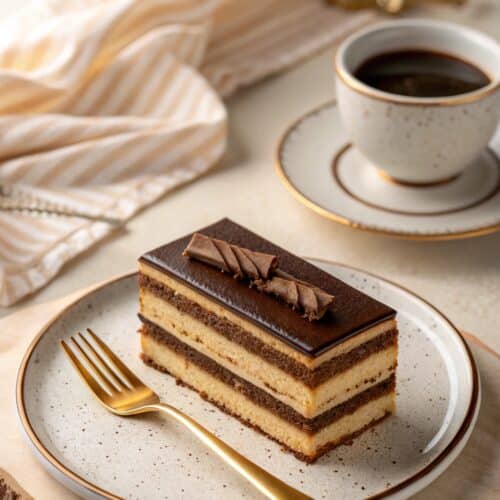
Opera Cake
Equipment
Ingredients
- For the Joconde Sponge:
- 6 large eggs
- 6 egg whites
- 150 g almond flour
- 200 g powdered sugar
- 60 g all-purpose flour
- 200 g unsalted butter melted
- For the Coffee Syrup:
- 250 ml strong espresso or coffee
- 100 g granulated sugar
- For the Coffee Buttercream:
- 5 egg yolks
- 200 g unsalted butter softened
- 150 g granulated sugar
- 50 ml water
- 1 tbsp coffee extract or strong espresso
- For the Ganache:
- 200 g dark chocolate 70%
- 200 ml heavy cream
Instructions
- Preheat oven to 425°F (220°C) and line a sheet pan with parchment paper.
- Whip the egg whites until stiff peaks form. Set aside.
- In a separate bowl, beat whole eggs with almond flour and powdered sugar until thick and pale.
- Gently fold in the flour and melted butter, then fold in the egg whites carefully.
- Spread the batter evenly into the sheet pan and bake for 6–8 minutes or until golden.
- Make the syrup: boil espresso and sugar together for 2–3 minutes, then cool.
- For the buttercream, heat sugar and water to 240°F, then slowly beat into whipped yolks. Let cool, then beat in softened butter and coffee extract.
- For ganache, heat the cream until steaming, pour over chopped chocolate, wait 1 minute, then stir smooth.
- Cut the sponge into 3 layers. Brush the first with coffee syrup, spread buttercream, and repeat.
- Finish with ganache on top. Chill at least 2 hours before slicing cleanly.
Notes
Nutrition
Table of Contents
The Story Behind Opera Cake
A French Dessert with a Legendary Past
Opera cake has its roots in Paris, where patisserie is equal parts tradition and showmanship. Some say the first official version appeared at Dalloyau, a historic Parisian bakery, while others credit pastry chef Cyriaque Gavillon for naming it “Opera” to reflect its grandeur. What makes opera cake stand out is its layered precision—almond sponge (called joconde), coffee buttercream, chocolate ganache, and a glossy glaze that sings like the final note of an aria.
My first encounter with opera cake wasn’t in a glamorous Paris café, but in my small North Carolina kitchen. After tasting a sliver at a bakery, I became obsessed with recreating those perfect layers. Much like when I baked my first chocolate cake at twelve, this recipe challenged me with patience and detail. But every attempt felt like a concert performance, where flavors harmonized into something more than the sum of their parts.
Why Opera Cake Is Worth the Effort
Unlike a simple chocolate cake or a quick banana cream cake, opera cake demands attention to detail. Each layer has a purpose: the almond sponge gives structure, the coffee syrup deepens flavor, the buttercream smooths it out, and the ganache locks everything together. That balance is why it continues to be one of the most beloved French pastries. If you’ve tried recipes like a German chocolate cake or a strawberry earthquake cake, you’ll notice opera cake takes indulgence to another level, blending sophistication with pure comfort.
Creating this dessert at home transforms your kitchen into a patisserie. The best part? Once you master opera cake, you’ll feel confident tackling other layered beauties, whether that’s a matcha cake or a chocolate mousse cake. With its rich coffee and chocolate notes, opera cake is more than a recipe—it’s an experience.
How to Make Opera Cake at Home
Step-by-Step Assembly for Beginners
Making opera cake may seem intimidating, but when broken into steps, it’s manageable. First, prepare the almond sponge (joconde). Whip eggs and sugar until pale, then fold in almond flour and a touch of all-purpose flour for structure. Spread the batter thinly on parchment-lined pans and bake until golden. Once cooled, trim the sponge into even rectangles—this becomes the base of your cake.
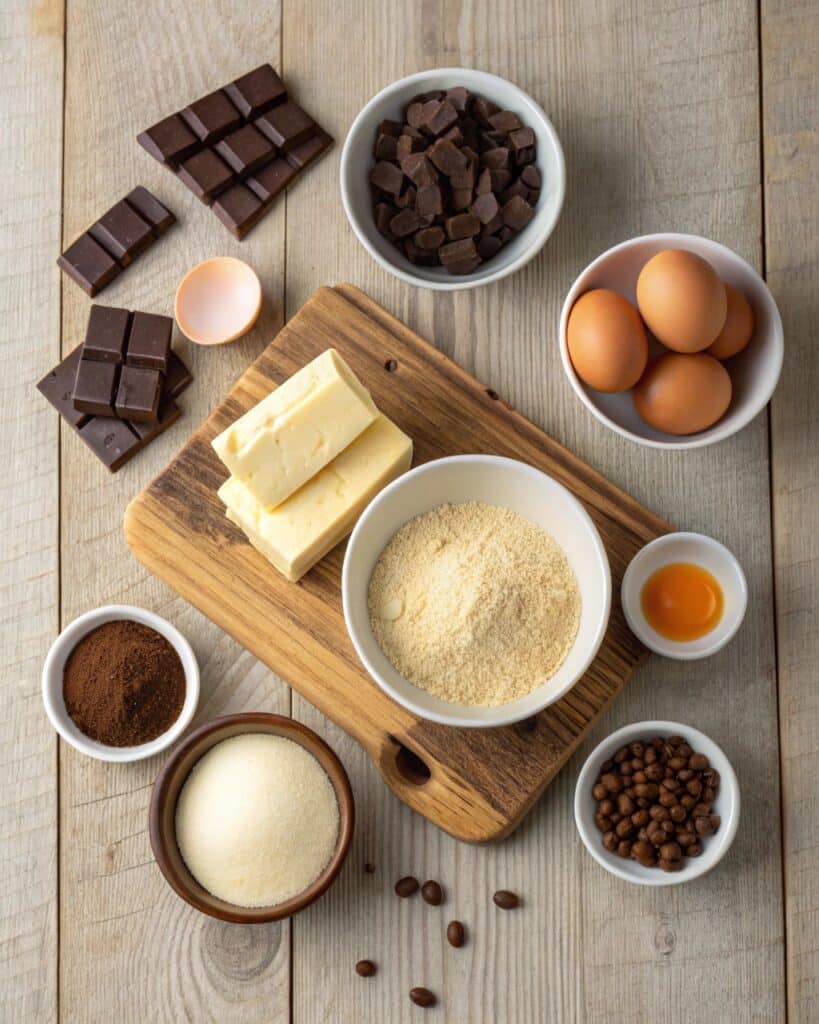
Next, create a strong espresso syrup. This is brushed onto each sponge layer, ensuring moisture and depth of flavor. Then comes the coffee buttercream, prepared by whipping butter with a coffee-flavored sugar syrup until silky. Spread a thin layer of buttercream over the first sponge. Add another sponge, brush with syrup, and top with a thin coat of chocolate ganache. Repeat the layering—sponge, syrup, buttercream, sponge, syrup, ganache—until you reach the top. The final flourish is a shiny chocolate glaze, poured smoothly across the surface. Chill before slicing to reveal those signature stripes.
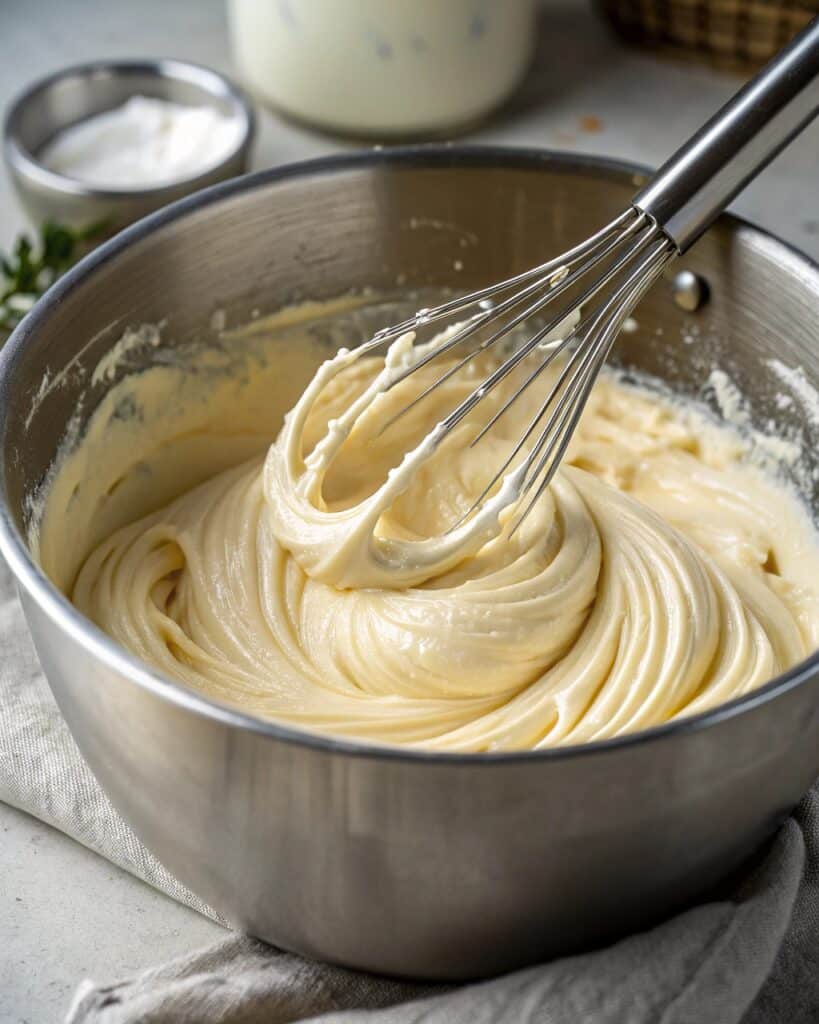
Here’s a simplified ingredient breakdown:
Opera Cake Ingredient Guide
| Component | Key Ingredients |
|---|---|
| Joconde Sponge | Almond flour, all-purpose flour, eggs, powdered sugar, butter |
| Coffee Syrup | Strong brewed espresso or instant coffee, sugar, water |
| French Buttercream | Egg yolks, sugar syrup, unsalted butter, coffee extract |
| Chocolate Ganache | Dark chocolate, heavy cream |
Tips for Perfect Results at Home
Patience and precision are the secrets to success. Keep the sponge thin and flexible, or it will crumble under the layers. Use high-quality dark chocolate for both the ganache and glaze—it creates a smoother finish and richer taste. Chill each layer briefly before adding the next so everything sets evenly. When slicing, dip a sharp knife in hot water and wipe clean between cuts to achieve bakery-perfect slices.
If you’re used to simple bakes like coffee cake muffins or a carrot cake recipe, you’ll notice opera cake requires more steps, but the payoff is stunning. Every slice looks like a piece of art and tastes like one too. And while it takes more time than a vegan chocolate cake or a lemon pound cake, the result is worth every effort.
How to Make Opera Cake Step by Step (With Photos)
Start by baking the sponge. You’ll want it thin and even—use a large baking sheet and parchment to help. After baking, let it cool completely, then cut the sponge into three equal layers.
Next, prepare the espresso syrup and brush it onto each sponge layer. Don’t drench—just moisten to infuse flavor without sogginess.
Now it’s time to build:
- Place one sponge layer on a serving tray and brush with syrup.
- Spread a generous layer of coffee buttercream evenly on top.
- Add the second sponge, brush again, then spread a thin layer of ganache.
- Add the final sponge layer, soak it lightly, and top with another layer of buttercream.
- Finish with a smooth ganache glaze over the top.
Chill the cake for at least 2 hours to let the layers set. When you’re ready to serve, trim the edges for a clean finish and cut with a hot, sharp knife for that classic café look.
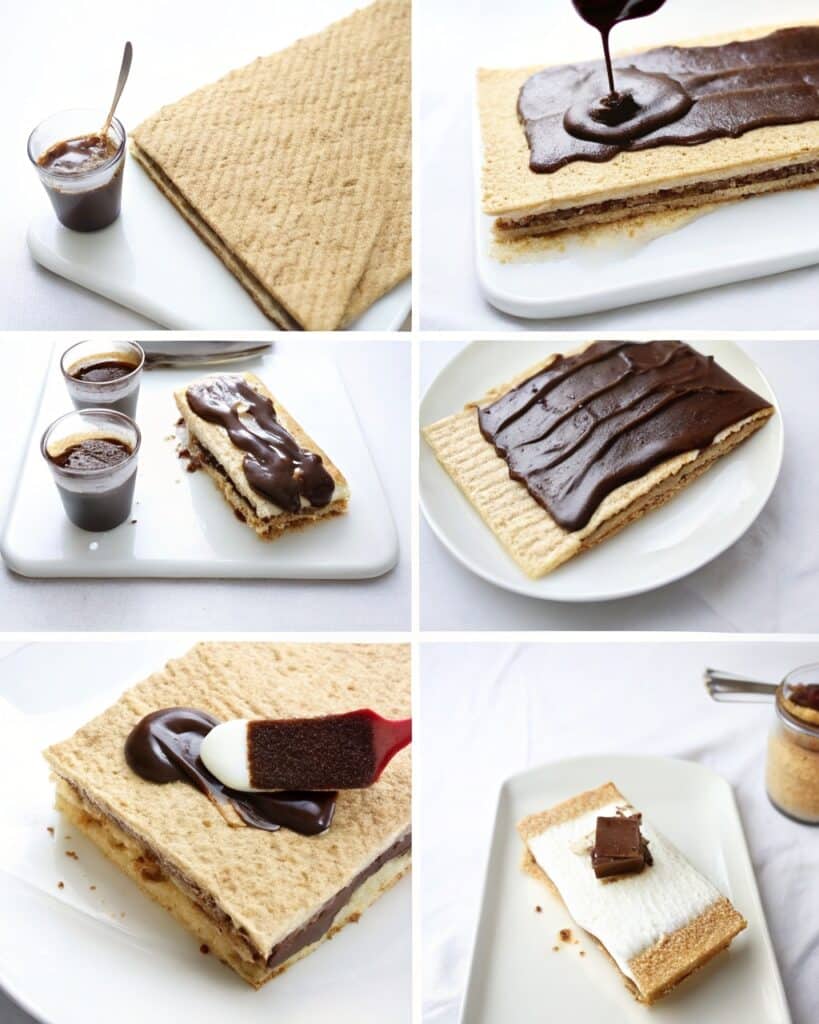
Variations and Serving Ideas for Opera Cake
Creative Twists on the Classic
While the traditional opera cake relies on almond sponge, coffee syrup, silky buttercream, and chocolate ganache, modern bakers enjoy putting their own spin on it. Some replace the coffee with fruit flavors such as raspberry or orange for a lighter twist, while others pair the almond sponge with matcha buttercream for a bold, green contrast. Nut-based versions, like pistachio or hazelnut buttercream, add extra richness. Even the ganache layer can be reinvented with white or ruby chocolate for a unique look. For plant-based diets, vegan bakers recreate the structure with dairy-free ganache and buttercream, proving the dessert’s adaptability.
These variations show how flexible the opera cake can be. A citrus-infused buttercream paired with almond sponge creates a refreshing summer dessert, while a raspberry ganache layer feels perfect for Valentine’s Day. Much like experimenting with a strawberry matcha cake or a vegan carrot cake recipe, small changes completely transform the mood and taste.
How to Serve Opera Cake Like a Pro
Presentation is everything with a dessert as elegant as opera cake. Use a sharp, warm knife to reveal the neat layers of almond sponge, coffee syrup, buttercream, and ganache. Pair slices with a shot of espresso or a glass of dessert wine to highlight the cake’s coffee and chocolate depth. For special occasions, decorate with chocolate curls or even gold leaf to echo the sophistication of classic French pâtisserie.
If you enjoy cakes with dramatic flair, you might also admire the craftsmanship of a lambeth cake or the glamour of a dubai chocolate cake. Opera cake also stores beautifully: wrap it tightly, freeze for up to a month, and thaw overnight. This make-ahead option ensures you always have a luxurious dessert ready to impress guests.
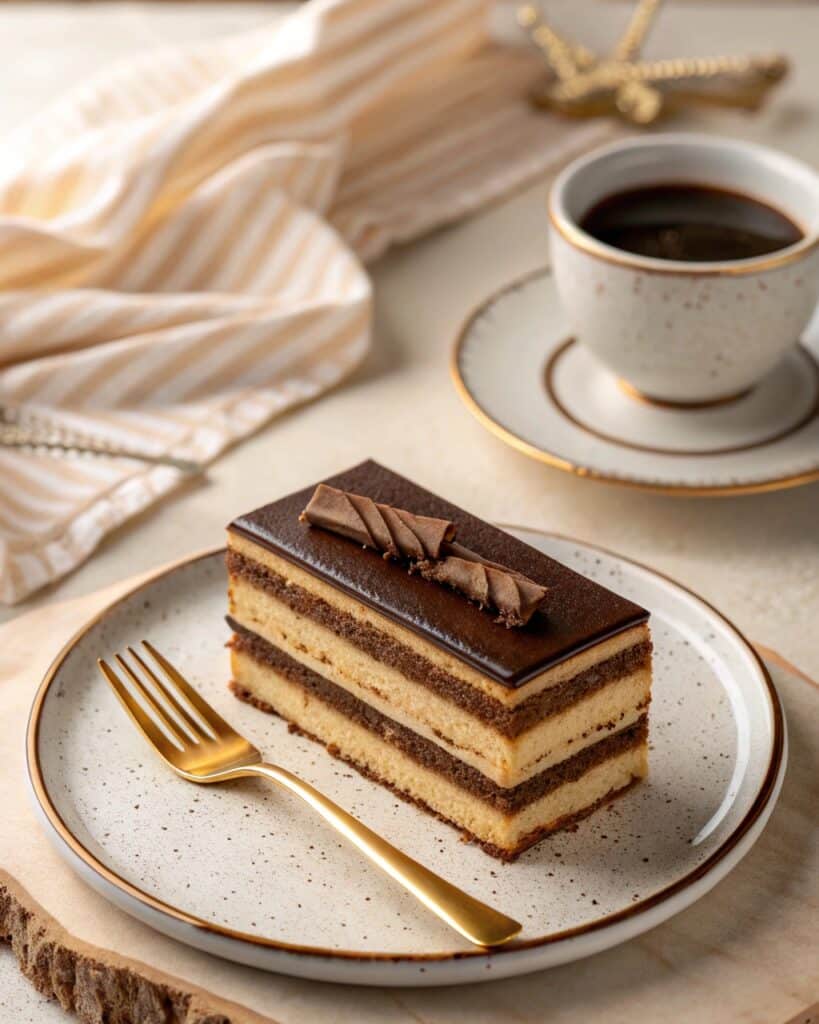
For more cake recipe follow us in Facebook Page Or Pinterest
FAQ
Why do they call it an opera cake?
The opera cake is said to be named after the Paris Opera, where the cake’s elegant layers and luxurious presentation mimic the grandeur and drama of a stage performance. Some say the cake was designed to resemble the layered balconies of an opera house.
What is the difference between tiramisu and opera cake?
While both desserts feature coffee and layers, tiramisu is Italian and made with ladyfingers soaked in espresso and layered with mascarpone cream. Opera cake, on the other hand, is French and uses almond sponge, coffee buttercream, and ganache, resulting in a more structured and formal presentation.
What is a classic opera cake?
A classic opera cake includes thin layers of almond Joconde sponge soaked in coffee syrup, filled with coffee-flavored French buttercream and dark chocolate ganache, then topped with a shiny chocolate glaze. It’s known for its precise layers and rich, elegant taste.
What does opera cake taste like?
Opera cake tastes like a blend of bittersweet chocolate, bold coffee, and buttery almond sponge. It’s rich and creamy with just enough sweetness. Each bite delivers depth, with contrasting textures from the sponge, buttercream, and ganache layers.
Conclusion
Opera cake isn’t just dessert—it’s a process, a mood, and a little slice of culinary artistry. From the carefully brushed coffee syrup to the silky French buttercream, every step invites you to slow down and create something memorable. It might take some patience, but the reward? A show-stopping cake that tastes like a standing ovation.
Whether you’re baking for a special occasion or simply craving something elegant and bold, opera cake delivers. And if you’re just beginning your baking journey, don’t worry—I’ve got plenty of approachable recipes like my simple chocolate buttercream cake or the always-loved fudge brownie torte waiting for you on easychocolatecake.net.

